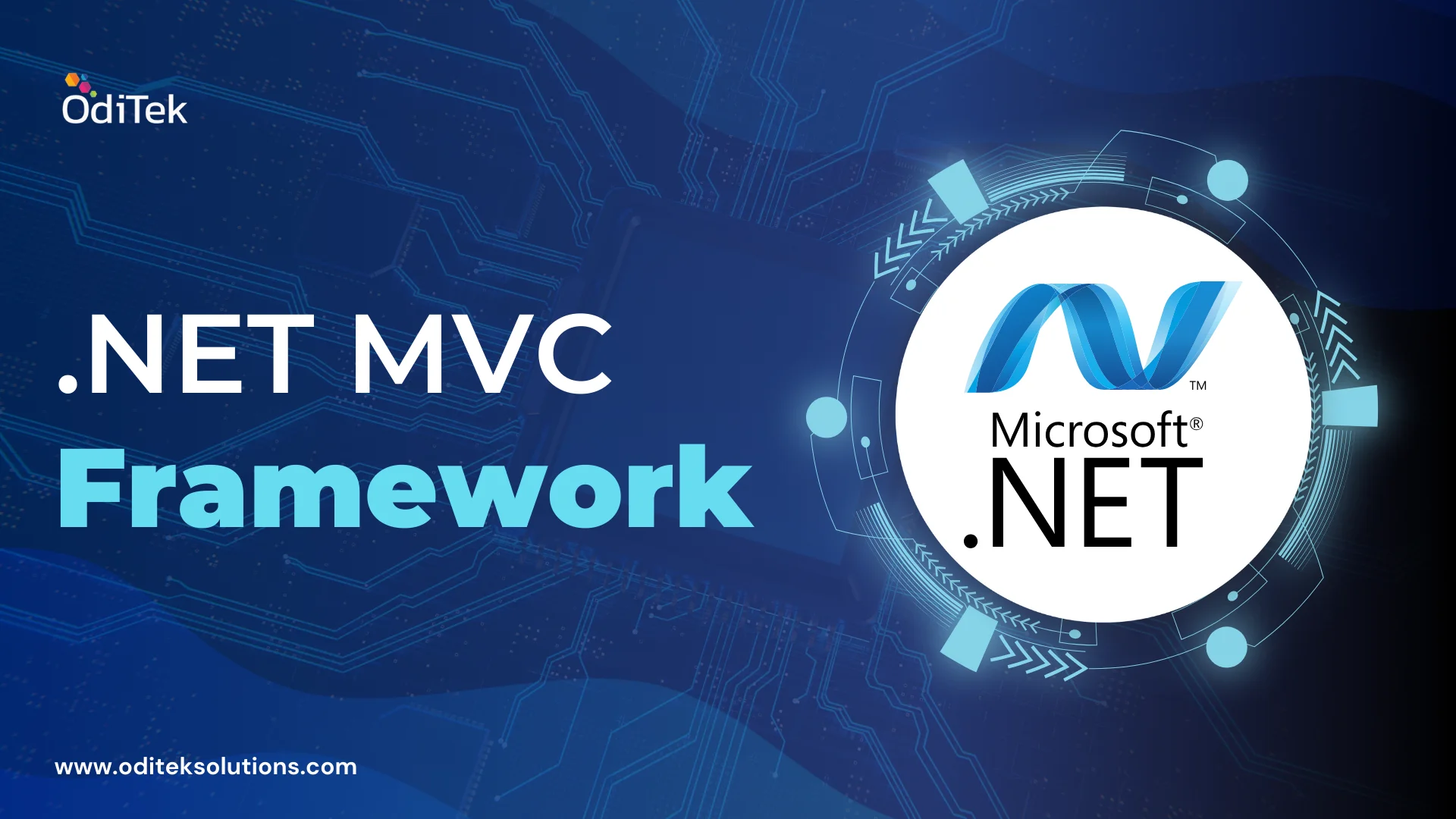In today’s rapidly evolving tech landscape, businesses require web applications that are scalable, secure, and maintainable. The ASP.NET MVC framework has emerged as one of the most powerful tools for building robust, data-driven web applications. This guide offers a concise overview of the .NET MVC framework, its key benefits, and how OdiTeK Solutions leverages it to build professional-grade applications tailored to our clients’ needs. Whether you’re a developer or a business owner exploring web development options, this guide will help you understand why ASP.NET MVC is the right choice for your next project.
Introduction to .NET MVC
The ASP .NET Framework MVC is part of Microsoft’s .NET platform and provides developers with a high degree of control over HTML, CSS, and JavaScript. Unlike traditional web frameworks that follow a Page Controller pattern (such as Web Forms), MVC implements a Model-View-Controller architecture, promoting separation of concerns.
MVC’s Key Components
• Model: Represents the application’s data and business rules.
• View: The component responsible for rendering the user interface (UI) and presenting data to the user.
• Controller: Manages user input and interactions, updating the View and Model accordingly.
Benefits of Using ASP.NET MVC
Why should you choose ASP.NET MVC for your next project? Here are some compelling reasons:
1. Separation of Concerns
MVC’s clear distinction between the Model, View, and Controller simplifies complex development. This approach encourages clean architecture, where each component is independent, leading to more organized, maintainable code.
2. Testability
ASP .NET Framework MVC supports unit testing and facilitates the use of Test-Driven Development (TDD). You can independently test each component of the application, ensuring that it functions as intended and that changes won’t break other parts of the application.
3. SEO-Friendly URLs
The framework’s routing system allows you to create user-friendly URLs that are essential for Search Engine Optimization (SEO). This is particularly important for businesses that want their websites to rank higher on search engines.
4. Extensibility and Flexibility
ASP.NET MVC allows developers to easily integrate with JavaScript frameworks, RESTful APIs, and third-party libraries. Additionally, it supports dependency injection (DI), allowing more flexibility in managing the application’s services.
5. Cross-Platform Development
With the release of ASP.NET Core MVC, developers can now build cross-platform applications that run seamlessly on Windows, Linux, and macOS. This allows businesses to deploy their web apps across a variety of operating systems.
Core Features of .NET MVC
1. Routing
MVC’s routing system is highly flexible, enabling you to map URL patterns to specific controllers and actions. This is critical for creating intuitive and meaningful URL structures that are both user-friendly and SEO-optimized.
2. Razor View Engine
The Razor view engine simplifies the integration of C# code within HTML. Its clean and compact syntax ensures that your views (UI) remain lightweight and fast, improving the overall performance of your web application.
3. Data Annotations for Validation
ASP .NET Framework MVC allows you to apply validation rules using Data Annotations. This ensures that all user inputs meet the defined criteria before they are processed by the server.
4. Asynchronous Support
MVC fully supports asynchronous programming, making it ideal for applications that need to perform multiple operations simultaneously, such as fetching data from an external API while maintaining a responsive user interface.
Best Practices for ASP.NET MVC Development
Here are some best practices that ensure professional, high-quality applications:
1. Thin Controllers, Rich Models
Your controllers should be kept as simple as possible, focusing only on coordinating between the Model and the View. All business logic should reside in the Model or Service Layer.
2. Optimize Views for Performance
Keep your views efficient by minimizing the use of loops, large datasets, and complex logic inside Razor templates. Using View Components or Partial Views helps modularize your UI components, making them easier to reuse and optimize.
3. Dependency Injection
Using DI containers such as Autofac or Microsoft’s built-in DI helps create loosely coupled, maintainable code. This also makes it easier to swap implementations or add new dependencies without breaking the system.
4. Follow REST Principles for API Development
When building APIs using ASP.NET MVC, adhere to RESTful principles for better organization and scalability. Use appropriate HTTP methods (GET, POST, PUT, DELETE), and design your API endpoints in a logical, resource-oriented manner.
Real-World Applications of .NET MVC
Many high-traffic web applications leverage the .NET MVC framework due to its scalability, security, and flexibility.
1. E-commerce Platforms
ASP.NET MVC is widely used to build scalable, high-performing e-commerce websites. Its modularity allows for the development of custom features like product catalogues, shopping carts, payment gateways, and real-time order tracking.
2. Enterprise Web Applications
From Enterprise Resource Planning (ERP) systems to Customer Relationship Management (CRM) software, ASP.NET MVC is perfect for building large-scale applications that require real-time data processing, business workflows, and custom reporting dashboards.
3. Social Media Applications
MVC’s asynchronous capabilities make it suitable for building social platforms where real-time updates and high user interactions are crucial.
ASP.NET Core MVC: The Future of Web Development
With the advent of ASP.NET Core MVC, developers can now build more lightweight, cross-platform applications. The framework is designed for cloud-based and internet-connected applications like mobile backends, microservices, and modern web apps.
Benefits of ASP.NET Core MVC
• Cross-platform support: Works on Windows, Linux, and macOS.
• High performance: Optimized for performance with a minimal footprint.
• Cloud-native: Integrates seamlessly with cloud platforms like Microsoft Azure for deploying web apps in the cloud.
Conclusion
The ASP .NET MVC framework is a powerful, versatile tool for building modern, scalable, and secure web applications. Its modular architecture, combined with features like routing, Razor syntax, and data validation, promotes clean, high-performance code. Whether you’re a developer expanding your skills or a business seeking a dynamic web solution, ASP.NET MVC is an ideal choice.
At OdiTeK Solutions, we leverage the latest technologies and best practices to create tailored, future-proof applications. If you’re ready to explore the benefits of .NET MVC for your next project, contact us today!







